
- 4.85% APY on USD balances
- $0 monthly fees
- Up to $100 free ATMs withdrawals worldwide
- Hold and convert 40+ currencies
Travelers to Canada will be glad to hear that you can use your cards in the same types of places as you would at home. There’s a similar number of ATMs and banks, and prices for accommodation and food are more or less the same — though it gets more expensive in specific cities, or if you’re going skiing or snowboarding.
A credit card that doesn’t charge foreign transaction fees is ideal to keep those pesky additional expenses away. Here’s a look at all of your purchasing options in Canada.

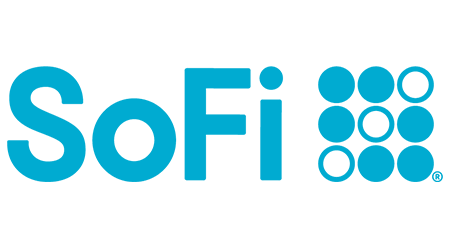

Don’t stress about using your card to make purchases and to withdraw cash — card acceptance and ATM availability are similar to the US. Canadian merchants accept Visa, Mastercard and American Express credit cards.
Canada uses Interac Direct Payment (IDP) and you can use this system to get cash out over-the-counter if you’re paying with your debit or travel card. Travel cards, debit cards and credit cards are all worth comparing before you head out on your trip.
Even though you can get away with making card payment a lot of the time, there are still instances when you’ll need cash. Take a combination of the travel money products and use the right card for the right situation so you can save on international transaction charges.
Do your research before you leave so you can enjoy your trip to Canada with peace of mind that you’re spending your money smart and not giving it to your bank.
Credit cards are a good way to make purchases, but it’s recommended you use your debit card when making ATM withdrawals. Cash-advance fees and interest can add up and give you a nasty surprise when you arrive home. You can avoid some unnecessary fees by picking up a credit card that waives foreign transaction fees, like the Capital One VentureOne Rewards Credit Card (Terms apply, see rates & fees).
Some travel cards also come with additional benefits like rewards, statement credits and travel insurance. These perks can offer great value, so compare travel credit cards to find one that fits your travel needs.
| Merchant acceptance | ATM acceptance | |
|---|---|---|
| Visa | ||
| Mastercard | ||
| American Express | ||
| Discover |
Explore top debit cards with no foreign transaction fees and travel credit cards by using the tabs to narrow down your options. Select Compare for up to four products to see their benefits side by side.
The Finder Score crunches over 300 checking accounts from hundreds of financial institutions. It takes into account the product's monthly fees, overdraft fees, opening deposit, customer support options, ATM network and features — this gives you a simple score out of 10.
To provide a Score, Finder’s banking experts analyze hundreds of checking accounts against what we consider is the best option: no monthly fees, no overdraft fees, a large ATM network of 50,000 or more, additional features outside of typical banking services, and the optional perk of earning interest. Accounts that are nearly free to maintain and use are scored the highest, while accounts with costly fees and few features are scored the lowest.
Look for a card that doesn’t charge for foreign exchange, international ATM fee and has no monthly or account keeping fees, like one from Betterment Checking. If you want to take your everyday debit card with you, you’ll most likely pay $5 for international ATM withdrawals, plus the ATM operator fee and a 3% currency conversion fee.
Travel cards let you spend Canadian dollars in Canada, helping you avoid the fee for currency conversion. While you can avoid currency conversion fees, look for international ATM that waive fees to save on withdrawal costs.
There are always going to be times when you need to pay with cash, especially if you’re buying something small — some merchants won’t accept a card for a small payment due to surcharge fees.
If you’re wondering the best way to exchange US dollars for Canadian dollars, you have these options:
Traveler’s checks have become a thing of the past when compared to the other forms of travel money compared for the following reasons:
The Canadian dollar has become stronger against the US dollar in the past five years. That being said, when you exchange your money, it might not stretch as far when traveling in Canada.
Live Rate
Refreshing in: 60s | Tue, Dec 17, 12:46PM GMT
The Canadian dollar is one of the most traded currencies in the world, it’s referred to as the “loonie.” This can be traced back to 1987 when Canada stopped minting paper currency for the $1 bill and turned to coins. The animal on the reverse side of the $1 coin is the loon.
Common Canadian dollar banknotes:
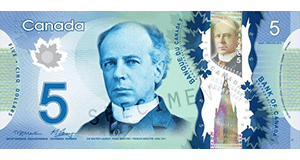 | 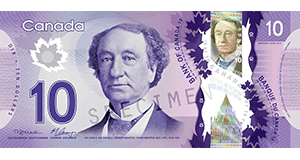 | 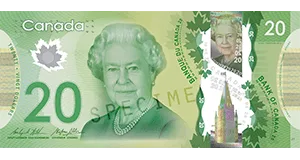 |
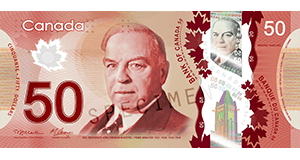 | 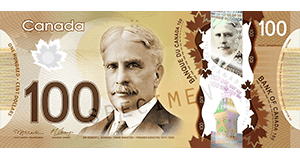 |
Look for the Visa, Visa PLUS or Mastercard logo on the front of the machine to see whether you can use your card to get cash. A local ATM operator fee applies each time you withdraw cash. This fee is comparable to the US where you’ll pay $2 to $3 each time your withdraw in addition to international ATM charges and currency conversion charges.
However, some debit cards are more travel friendly and will waive international ATM charges, such as the one from Betterment Checking.
Pickpocketing can happen anywhere, although it isn’t a huge problem in Canada — certainly not as problematic as it is in Europe. Nevertheless, remain vigilant, especially in larger cities and always stay aware of your surroundings. Keep your belongings close, even if you’re in a supposedly safe place like a restaurant.
To decrease the chances your cards or cash getting stolen, consider keeping it in a money belt. This is a fabric pouch that you wear around your waist and hide under your shirt or in your pants. Also, consider neck pouches, hidden pockets or a belt with hidden pockets.
Canada and the US are similar countries when it comes to daily spending and vacation expenses. Like all places around the world, prices jump up significantly in ski resorts. So, you’re going to need more cash if you head up the slopes. All prices are in US dollars.
| Whistler | Budget | Mid-range | Expensive |
|---|---|---|---|
| Accommodation | Motel (Whistler) $90 per night Hostel (Winnipeg) $30 per night | 3-star hotel (Whistler) $200–$300 per night 3-star hotel (Winnipeg) $100 per night | 5-star hotel (Whistler) $400–$500 per night 4-star hotel (Winnipeg) $150 per night |
| Meals | Whistler’s best burgers $10–$15 Drive-in fast food (Winnipeg) $4–$8 | Mexican food (Whistler) $20 Pub food (Winnipeg) $10–$20 | Araxi restaurant 10 oz. steak (Whistler) $54 Angus Sirloin (Winnipeg) $36 |
| Activities | Snowshoe walking tour (Whistler) $80 per person Manitoba Museum (Winnipeg) $7 per person | 10 days skiing (Whistler) $750 WWII Historical Walking Tour (Westminster) $80 per person | Sea to Sky Exotic Driving (Whistler) $800 White water rafting (Winnipeg) $120 |
Prices are approximate and are subject to change.
Michael spent a season skiing Canada’s famous peaks: Whistler and Blackcomb. The season lasts for approximately six months starting in November and ending around May.
Michael’s tips for managing travel money in Canada
Michael says he had savings in his US bank account, and he needed to transfer this money to his new Canadian account. He made a lump sum transfer every month or two. He recommends the services of OFX, a foreign exchange and international payments company.
If you’re planning on hitting the slopes while you’re in Canada, make sure that you have additional insurance. Compare travel insurance policies and protect your trip today.
Back to topHow to pay, how much to bring and travel money suggestions for your trip to USA.
How to pay, how much to bring and travel money suggestions for your trip to New Zealand.
How to pay, how much to bring and travel money suggestions for your trip to Thailand.
How to pay, how much to bring and travel money suggestions for your trip to Vietnam.
How to pay, how much to bring and travel money suggestions for your trip to Mexico.
How to pay, how much to bring and travel money suggestions for your trip to Portugal.
How to pay, how much to bring and travel money suggestions for your trip to Germany.
How to pay, how much to bring and travel money suggestions for your trip to Ecuador.
How to pay, how much to bring and travel money suggestions for your trip to Japan.